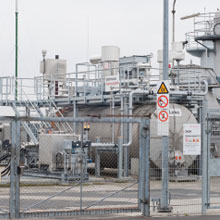Article by Investment U

Let’s go through each step of the process. I think after a procedural analysis, you’ll see why a debate has formed concerning the fracking process.
I have a friend who’s into science fiction and the SyFy network. A few years ago he joined the cult following of Battlestar Galactica – a remake of the sci-fi show I use to watch as a kid on television in the 70s.
One of his points asserting to the show’s brilliance was the manner in which it created its own language in order to use profanity on regular cable television. Can you really censor a word that doesn’t exist?
Imagine my surprise a couple of years ago when I actually saw one of these word in a financial publication. How did they know about “frack?” Better yet, they were using it as a verb.
You can use your imagination as to what the word “frack” was substituted for in our language. However, I think it’s important that we all know the meaning and the debate regarding “fracking” in our real world.
The Fracking Process…
Fracking is formally known as hydraulic fracturing. At least how it’s used in domestic oil drilling in shale rock formations. In these types of formations it’s referred to as “tight oil.” This means the oil is found within the rock itself. It’s not like the process we’ve seen on television and movies for years where there’s a big drill looking for a large reservoir of oil miles underground.
Let’s go through each step of the process. I think after a procedural analysis, you’ll see why a debate has formed concerning the fracking process:
- Drill a hole into the rock. With formations that have become extremely publicized over the last few years, like the Bakken in North Dakota, it’s usually 10,000 feet down and then 10,000 feet sideways.
- After the initial hole is drilled, a pipe that consists of a series of small holes is lowered into the drill hole.
- Through the holes several small explosions create fissures in the rock. This is done in stages throughout the length of the drilled hole.
- Once that’s completed, a combination of water, sand and chemicals is pushed into the drill hole with tremendous force.
- The force of the water pushes the sand and ceramics deep into the thousands of fissures as the mixture props open the small cracks.
- The natural gas or oil flows out of the cracks and into the drill hole and then up to the surface.
Not Without Controversy
There are two camps out there right now:
One believes the fracking process will be a huge part of the present and future of domestic oil and gas production. At the present, the U.S. oil market could be at the beginning of a boom similar to what the natural gas market is already experiencing. As a result, domestic production is now projected to rise significantly over the coming decades, reducing the relative share of imports in U.S. oil consumption.
The other camp believes that the importance of fracking is overstated, won’t drive down oil prices and comes with a steep environmental cost. The chemicals added in Step 4 of the fracking process only make up about 1% of the total mixture. Some companies actually post which ones are utilized, but most companies do not. The chemicals in the water have become a major component of environmental concerns and we have no true time frame to judge what affect they actually have on ground water.
However you view the situation, fracking will be a prominent subject over the next few years as this country looks to gain more natural resource independence. As we creep through a recovery, oil prices may be the key of if or how soon we come out this current economic environment.
Good Investing,
Jason Jenkins
Article by Investment U